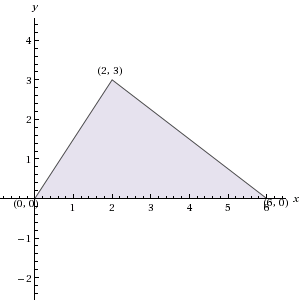All High School Math Resources
Example Questions
Example Question #11 : Isosceles Triangles
An isosceles triangle has an area of 12. If the ratio of the base to the height is 3:2, what is the length of the two equal sides?
6
5
3√3
4√3
4
5
Area of a triangle is ½ x base x height. Since base:height = 3:2, base = 1.5 height. Area = 12 = ½ x 1.5 height x height or 24/1.5 = height2. Height = 4. Base = 1.5 height = 6. Half the base and the height form the legs of a right triangle, with an equal leg of the isosceles triangle as the hypotenuse. This is a 3-4-5 right triangle.

Example Question #62 : Triangles
Two sides of a triangle each have length 6. All of the following could be the length of the third side EXCEPT
This question is about the Triangle Inequality, which states that in a triangle with two sides A and B, the third side must be greater than the absolute value of the difference between A and B and smaller than the sum of A and B.
Applying the Triangle Inequality to this problem, we see that the third side must be greater than the absolute value of the difference between the other two sides, which is |6-6|=0, and smaller than the sum of the two other sides, which is 6+6=12. The only answer choice that does not satisfy this range of possible values is 12 since the third side must be LESS than 12.
Example Question #1 : How To Find The Area Of An Acute / Obtuse Triangle
Find the area of a triangle whose base is 

This problem is solved using the geometric formula for the area of a triangle.
Convert feet to inches.
Example Question #112 : Triangles
If triangle ABC has vertices (0, 0), (6, 0), and (2, 3) in the xy-plane, what is the area of ABC?
9
20
18
12
10
Example Question #1 : How To Find The Area Of An Acute / Obtuse Triangle
What is the area of a triangle with a height of 

When searching for the area of a triangle we are looking for the amount of the space enclosed by the triangle.
The equation for area of a triangle is
Plug the values for base and height into the equation yielding
Then multiply the numbers together to arrive at the answer 
Example Question #113 : Triangles
The height, 



If 



Using the formula for the area of a triangle (


Example Question #187 : Plane Geometry
A triangle has a perimeter of 36 inches, and one side that is 12 inches long. The lengths of the other two sides have a ratio of 3:5. What is the length of the longest side of the triangle?
15
12
14
8
9
15
We know that the perimeter is 36 inches, and one side is 12. This means, the sum of the lengths of the other two sides are 24. The ratio between the two sides is 3:5, giving a total of 8 parts. We divide the remaining length, 24 inches, by 8 giving us 3. This means each part is 3. We multiply this by the ratio and get 9:15, meaning the longest side is 15 inches.
Example Question #1 : How To Find The Length Of The Side Of An Acute / Obtuse Triangle
A triangle has sides of length 8, 13, and L. Which of the following cannot equal L?
4
6
7
9
15
4
The sum of the lengths of two sides of a triangle cannot be less than the length of the third side. 8 + 4 = 12, which is less than 13.
Example Question #1 : How To Find The Length Of The Side Of An Acute / Obtuse Triangle
Two sides of a triangle are 20 and 32. Which of the following CANNOT be the third side of this triangle.
13
10
20
17
15
10
Please remember the Triangle Inequality Theorem, which states that the sum of any two sides of a triangle must be greater than the third side. Therefore, the correct answer is 10 because the sum of 10 and 20 would not be greater than the third side 32.
Example Question #561 : Geometry
A triangle has sides of length 5, 7, and x. Which of the following can NOT be a value of x?
5
3
7
13
11
13
The sum of the lengths of any two sides of a triangle must exceed the length of the third side; therefore, 5+7 > x, which cannot happen if x = 13.
All High School Math Resources
























